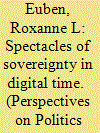|
|
|
Sort Order |
|
|
|
Items / Page
|
|
|
|
|
|
|
| Srl | Item |
| 1 |
ID:
128690


|
|
|
|
|
| Publication |
2014.
|
| Summary/Abstract |
Using materials gathered during fieldwork carried out in Russia in 2008 and 2009, this paper examines the 'Day of Stavropol' krai 2009' celebration and links it to debates on ethnic relations, identity and nationalism in post-Soviet Russia. It is argued that celebrations, festivals, parades and other 'spectacles' are significant, yet often overlooked, influences on ethnic relations. Although authorities at national and regional scale play a prominent role in governing ethnic relations, it is often the case that they revert to Soviet-era practices - such as the 'folklorization' of ethnic groups - and produce a narrative that proclaims the 'eternal harmony' of ethnic relations. Given widespread ethnic tensions that exist in Russia, such a representation of ethnic relations is far from the reality lived by people in everyday life. Thus, this paper explores how citizens' understandings of ethnic relations relates to that portrayed by state authorities.
|
|
|
|
|
|
|
|
|
|
|
|
|
|
|
|
| 2 |
ID:
156837


|
|
|
|
|
| Summary/Abstract |
The ISIS videos staging the executions of James Foley and Steven Sotloff are usually understood as devices to deter, recruit, and “sow terror.” Left unanswered are questions about how these videos work; to whom they are addressed; and what about them can so continuously bring new audiences into existence. The evident durability of ISIS despite the imminent defeat of its state, coupled with the political impact of these particular videos, make these questions unusually urgent. Complete answers require analysis of the most understudied aspect of the videos that also happens to be vastly understudied in US political science: the visual mode of the violence. Approaching these videos as visual texts in need of close reading shows that they are, among other things, enactments of “retaliatory humiliation” (defined by Islamists) that perform and produce an inversion of power in two registers. It symbolically converts the public abjection of Foley and Sotloff by the Islamist executioner into an enactment of ISIS’ invincibility and a demonstration of American impotence. It also aims to transpose the roles between the US, symbolically refigured as mass terrorist, failed sovereign, and rogue state, and ISIS, now repositioned as legitimate, invincible sovereign. Such rhetorical practices seek to actually constitute their audiences through the very visual and visceral power of their address. The affective power of this address is then extended and intensified by the temporality that conditions it—what I call digital time. Digital time has rendered increasingly rare ordinary moments of pause between rapid and repetitive cycles of reception and reaction—moments necessary for even a small measure of distance. The result is a sensibility, long in gestation but especially of this time, habituated to thinking less and feeling more, to quick response over deliberative action.
|
|
|
|
|
|
|
|
|
|
|
|
|
|
|
|
|
|
|
|
|